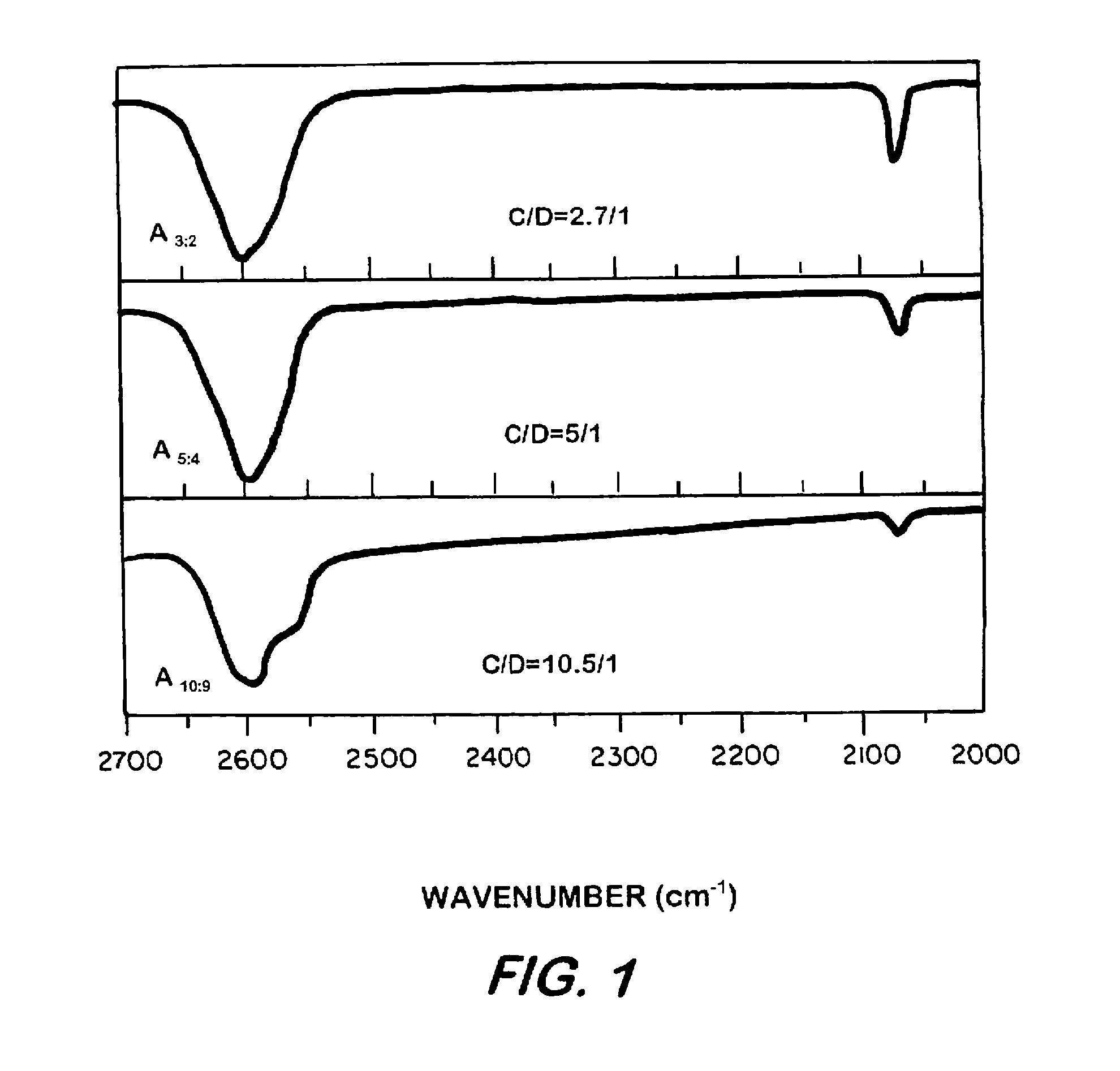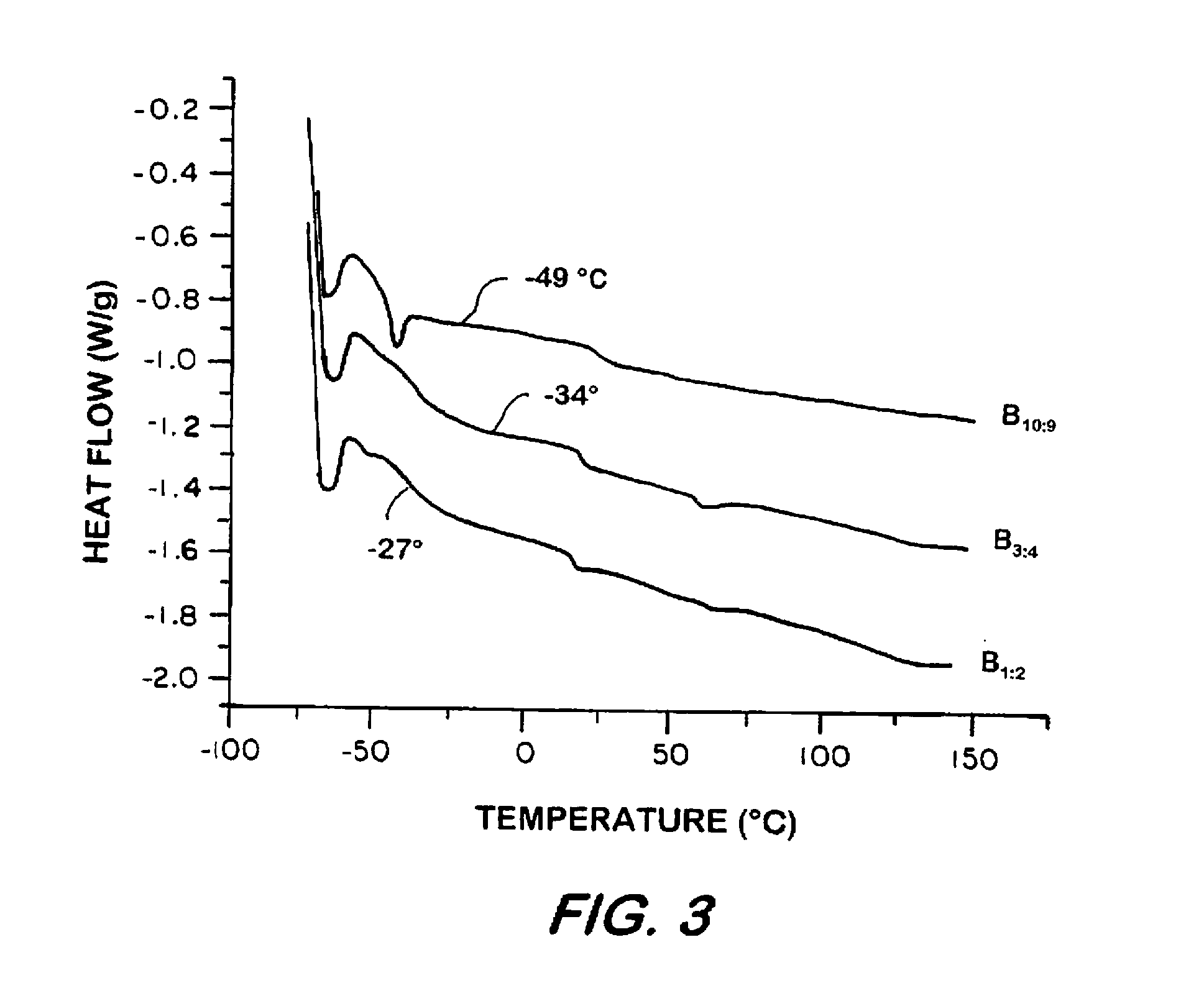Synthesis of elastomeric carborane-siloxanes by hydrosilation reactions
a technology of elastomeric carborane and siloxanes, which is applied in the field of siloxanecarborane polymers, can solve the problems of unsuitability of product characteristics (brittleness) and the inability to use these systems in elastomeric applications
- Summary
- Abstract
- Description
- Claims
- Application Information
AI Technical Summary
Benefits of technology
Problems solved by technology
Method used
Image
Examples
example 1
[0038]Synthesis of diacetylene-terminated poly(diacetylene-disiloxane-m-carborane)s—A flame-dried 100 mL Schlenk flask, under argon, containing THF (5 mL) was cooled in a dryice / 2-propanol bath (−78° C.). It was then treated with 7.29 mL of a 2.5 M n-butyl lithium solution (18.24 mmol) and was stirred for 15 min. After this period, 0.78 mL of hexachlorobutadiene (4.87 mmol, a slight excess when compared to 1,7-bis(chlorotetramethyldisiloxyl)m-carborane) was added drop wise via syringe in 20 min. After the addition was complete, the mixture was allowed to warm to room temperature and was stirred further for 3 h. The mixture was then cooled to −78° C. and 2.0 mL of 1,7-bis(chlorotetramethyldisiloxyl)m-carborane (4.43 mmol) was added via syringe. The mixture was then warmed to room temperature and was stirred further for 3 h. At this point, the mixture was cooled in an ice bath and was treated with 30 mL of cold saturated aqueous NH4Cl solution. The aqueous mixture was then extracted w...
example 2
[0039]Synthesis of siloxane / ol-terminated poly(diacetylene-disiloxane-m-carboranylene)s—A flame-dried 100 mL Schlenk flask, under argon, containing THF (5 mL) was cooled in a dryice / 2-propanol bath (−78° C.). It was then treated with 6.63 mL of a 2.5 M n-butyl lithium solution (16.58 mmol) and was stirred for 15 min. At this time, 0.71 ml of hexachlorobutadiene (4.43 mmol) was added drop wise via syringe in 20 min. After the addition was complete, the mixture was allowed to warm to room temperature and was stirred further for 3 h. The mixture was then cooled to −78° C. and 2.2 mL of 1,7-bis(chlorotetramethyldisiloxyl)m-carborane (4.87 mmol, slight excess when compared to hexachlorobutadiene) was added via syringe. The mixture was then warmed to room temperature and was stirred further for 3 h. After this period, the mixture was cooled in an ice bath and was treated with 30 mL of cold saturated aqueous NH4Cl solution. The aqueous mixture was then extracted with Et2O (3×20 mL). The et...
example 3
[0040]An alternative method for the synthesis of diacetylene-containing poly carboranylenesiloxanes—All of the diacetylene-containing poly carboranylenesiloxanes synthesized and described in Examples 1, 2, and 4–7, are very dark and opaque. A synthetic methodology was developed to make them transparent and hence, lighter in color. A procedure that is applicable to all of them is described below specifically for the product made in Example 2.
[0041]A flame-dried 100 mL Schlenk flask, under argon, containing THF (5 mL) was cooled in a dryice / 2-propanol bath (−78° C.). It was then treated with 6.63 mL of a 2.5 M n-butyl lithium solution (16.58 mmol) and was stirred for 15 min. At this time, 0.71 mL of hexachlorobutadiene (4.43 mmol) was added drop wise via syringe in 25 min. After the addition was complete, the mixture was stirred at this temperature for 20 min. 2.2 mL of 1,7-bis(chlorotetramethyldisiloxyl)m-carborane (4.87 mmol, slight excess when compared to hexachlorobutadiene) was t...
PUM
| Property | Measurement | Unit |
|---|---|---|
| temperature | aaaaa | aaaaa |
| temperature | aaaaa | aaaaa |
| wavelengths | aaaaa | aaaaa |
Abstract
Description
Claims
Application Information
 Login to View More
Login to View More - R&D
- Intellectual Property
- Life Sciences
- Materials
- Tech Scout
- Unparalleled Data Quality
- Higher Quality Content
- 60% Fewer Hallucinations
Browse by: Latest US Patents, China's latest patents, Technical Efficacy Thesaurus, Application Domain, Technology Topic, Popular Technical Reports.
© 2025 PatSnap. All rights reserved.Legal|Privacy policy|Modern Slavery Act Transparency Statement|Sitemap|About US| Contact US: help@patsnap.com



